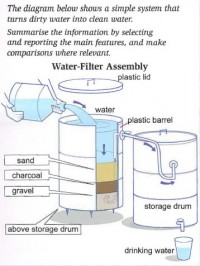Writing about a process: why be passive about it?
Eden BroughMany students entering level 4 of Foundations know that they might need to write about a chart or a table in Task 1 of their IELTS exam. Some of them also know that the question may be about a map or a combination of maps. The least well known type of question, however, appears to be the one where candidates have to write about a diagram describing a machine or a process and explain how these work. This lack of awareness most likely stems from the fact that questions like this are rare, so they have never heard about them from friends or relatives who have taken the test before.
Processes in IELTS textbooks
Task 1 questions of this type are covered in most IELTS textbooks though, whether as a diagram of a manufacturing process (e.g. how pencils are made), some sort of natural process (e.g. the water cycle), or some sort of device (e.g. an air bag in a car). These are usually done in a later chapter, after bar charts, pie charts, line graphs and tables have been covered, and most often are accompanied by a grammar feature on the use of the passive voice. For example, in Complete IELTS bands 4-5, this kind of question appears in unit 9 of a 10-unit textbook. The task is a diagram showing how a water filter works and the model answer is replete with examples of the passive voice (are placed next to, are linked by, is made by, is fixed to, etc.). This is followed by a short ‘Key grammar’ feature on the passive.

Building on what the students know
Although I use this course book with my students, I must admit that I have never actually used this material for a couple of reasons. Firstly, I have rarely got as far as unit 9, even in the old semester system, but more importantly I have preferred to use other materials for introducing students to questions like these. Since these are rare, it is natural that we should spend more time and focus on graphs and charts, but we are obliged to prepare our students for all eventualities as best we can. In my opinion, this is best done by building on the work we have done with the main types of charts and graphs. At first glance, diagrams showing processes appear to be very different from bar and pie charts, line graphs and tables. However, I try to show the students that they can still write about them using the same overall structure – including the same cohesive devices – as I have taught them for the main types of question. And most importantly, I avoid the passive voice.
Why avoid the passive?
Many teachers would argue that you need to use the passive to write about a process, but I feel it is too puzzling for many of our students and unnecessary for achieving the writing band they require. After continually correcting writing where students use the verb ‘to be’ as an erroneous auxiliary in present simple and past simple sentences, how can I now ask them to use it with a past participle without creating some kind of confusion? Instead I show them a way to write without using the passive, as whatever the process is, you can always say that ‘someone does it’.
Adapting materials
With time limited for teaching how to write about a process, I have focused solely on manufacturing processes. In particular I use two examples adapted from the CUP book Grammar for IELTS. Unsurprisingly, these come from a later unit in the book on ‘The passive’, but I only use the diagrams themselves as examples. The first is a flowchart showing how banana chips are made. I cut up the ten steps in the process and ask the students to reorder them, as a way of orienting them to the idea of sequencing. Prior to this, however, I will show them a video from YouTube on how potato chips are made, both to build schema and introduce some useful vocabulary. I should add, however, that the video does describe the process using the passive voice.

Following on from the re-ordering of steps, I give the students a gap-fill model answer and ask them to write in the verbs from a list. Most importantly, the model has the same basic structure as I have encouraged the students to use for charts and graphs, and there is no passive voice included. Instead, I explain that somebody does something. In this case it is ‘food companies’. For practice, I give them the question on canning fruit (from the same unit). Recently, I have also shown them a video on this process, which is rather outdated (and again includes the passive) but which the students seem to enjoy watching.

Some useful links and materials
Some easy to understand videos about the manufacture of potato chips:
https://www.youtube.com/watch?v=LkqBbr7Ewsw
An old video about fruit canning in Australia:
https://www.youtube.com/watch?v=WAYZCj8JNEM
Examples of clear manufacturing processes can be found in the following course books.
- IELTS Foundation Study Skills (p.46) (Macmillan)
- Grammar for IELTS (pp.194 & 197) (Cambridge University Press)
- IELTS Trainer (p.151) (Cambridge University Press)
- Focus on IELTS (p.85) (Pearson Longman)
The following is a worksheet for the lesson described above.